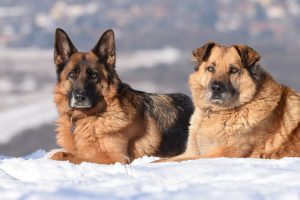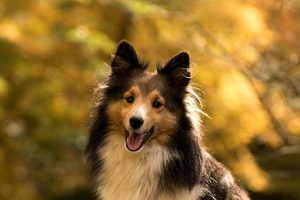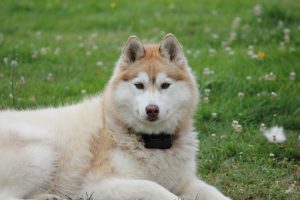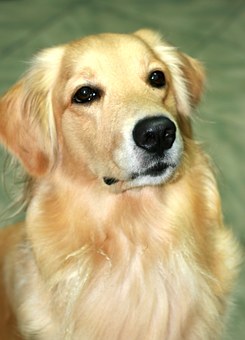Grooming these types of dogs takes a bit more work than a smooth short-haired dog even tho their hair may appear to be relatively short. They have an undercoat also referred to as a double coat, this coat has soft hair underneath the topcoat that acts as insulation with a coarser outer coat that is good at repelling water. The heavy coat can be long, short or a combo of both being silky but thick to the touch. Some breeds have a combination coat like the Golden Retriever. In this article, I will be helping you with grooming tips for the heavy coat, double coat and combo coated dog. Below is a list of breeds to give you an idea of what type of coats this article will be pertaining to.
- German Shepherds
- Alaskan Husky
- Akitas
- Alaskan Malamute
- Keeshond
- Pomeranian
- Samoyed
- Old English Sheepdog
- Shetland Sheepdog
- Newfoundland
- Golden Retriever
- Cardigan Welsh Corgi
- Chow Chows
- Rough Collie
- Pekingese
- Border Collies
Nature Protects with a nice Heavy Coat
By nature, these breeds, and dogs mixed with these breeds will grow a nice thick coat in the colder months to help keep them warm. As the temperature starts to warm up the undercoat will begin to shed. This process will vary according to where you live and how much time your dog spends outside. Dogs that live in places that stay warm to hot all year round will continuously shed. As the undercoat sheds it will fall out and cause matting as it gets tangled in with the topcoat, your dog will require a lot of extra brushing during this time.
warm up the undercoat will begin to shed. This process will vary according to where you live and how much time your dog spends outside. Dogs that live in places that stay warm to hot all year round will continuously shed. As the undercoat sheds it will fall out and cause matting as it gets tangled in with the topcoat, your dog will require a lot of extra brushing during this time.
Shedding is completely normal and no need to worry unless you notice bald spots, hot spots or any kind of irritations on your dog’s skin. You may need to get advice from your veterinarian as to what is causing the problem. Many dogs develop allergies over time and your vet can run tests to find the culprit. Fleas, ticks, and parasites will also cause skin irritation and excess shedding.
Do not bath your dog until you removed all of the loose undercoat and matted hair. Bathing a dog that is matted and has a heavy loose undercoat will only make things worse by tightening the hairs making it almost impossible to brush out. Once you have your dog all brushed out you can give him/her a bath. Your dog should be bathed at least once a month and no more than once a week. A lot will depend on your dog’s coat and skin condition as to how often he/she will need a bath.
You can follow my instructions on Bathing, Nail Trimming, Ear and Teeth Cleaning by Clicking Here!
Care for the Heavy Coat, Double Coat, and Combo Coat
Caring for a dog’s thick coat that has an undercoat requires frequent brushings, especially during the shedding season. A shedding blade works great at pulling out the loose undercoat, you can also use a slicker brush and/or a grooming rake.
When to use a Shedding Blade
A shedding blade is not a cutting blade that other shedding tools have, it has small teeth that are designed to grab loose hairs but can also scratch your dog’s skin. Do not use on the face, belly, and butt. Use the shedding blade first to remove as much hair as possible. You basically use the shedding blade the same way you use a brush, using gentle pressure as you stroke your dog’s coat. I recommend doing this outside or in a room that you don’t mind having hair fly all over the place.
When to use a Grooming Rake
Some areas of your dog’s coat may be too thick for the shedding blade. Especially around the neck, chest and behind his/her hind legs. A grooming rake works great for these areas. Some rakes are designed for removing tangles and mats without damaging the topcoat. Use in the same manner as a brush, lift the hair to get to the undercoat easily.
When to Use a Slicker Brush
After using the shedding blade and/or rake use the slicker brush along with a spray-on conditioner to smooth out the coat and remove any excess hair.
I recommend doing this procedure at least 1-2 times a week during the heavy shedding season and 2-3 times a month when shedding is not so bad.
Conditioners for the Heavy Coat, Double Coat, and Combo Coat
After bathing and at least once a week you should apply a coat conditioner. I recommend a leave-in spray conditioner for in-between baths when you’re ready to brush your dog.
How to apply a spray conditioner
Start at the head paying close attention not to get any of the sprays in the eyes or ears of your dog. Spray generously to make a nice even layer over your dog’s entire coat, but not too much or it will make the coat appear and feel greasy. Allow it to sit for a few minutes then begin to brush. Use a good Slicker Brush to work in the conditioner, always start at the head and work your way back spending more time brushing the thicker areas like around the neck. Then take a comb to catch any loose hairs the brushing missed. Doing this on a regular basis will help prevent the hair from matting and will reduce the amount of hair all over your house.
Benefits of using a spray conditioner
- Conditioning after bathing helps to seal the hair shafts to lock in moisture, this prevents the hair from being dry and brittle.
- Makes brushing easier, most conditioners contain a detangler.
- Prolongs the sheen and coat condition.
- It helps to keep your dogs skin from getting dry.
- It helps to repair damaged hair.
Choosing a good conditioner
Choosing the right conditioner can be as confusing as choosing the right shampoo. I recommend looking for an all-natural conditioner that can be used often. Always  read the ingredients to make sure it does not contain anything that your dog may be allergic to and never use products made for people, our PH levels are totally different from your dogs.
read the ingredients to make sure it does not contain anything that your dog may be allergic to and never use products made for people, our PH levels are totally different from your dogs.
Ingredients to look for
- Citric acids
- Hydrolyzed wheat protein
- Silk protein
- Tea tree leaf oils
- Wheat germ
- amino acids
- vitamins A, D, and E
- Aloe
Ingredients to avoid
- Alcohol
- Harsh Chemicals
- Heavily scented products
For more info on how to choose a good coat conditioner please visit The Best Hair Conditioners for dogs and cats.
What to Trim
Trim away any hairs that are growing over the pads of the feet. You may find your dog to be a bit jumpy when touching their feet, I recommend doing this with clippers and not a scissor. Clippers are safer to use on the pads. If you choose to use a scissor be very careful not to cut your dog’s pads. You can also trim away long hairs from between the toes and hock.
Recommended Tools for the Heavy Coat, Double Coat, and Combo Coat
Shedding Blade
I found the Shires Metal Sweat Scraper to be one of the better shedding blades being it has a double blade to catch more hair.
Best deal found on Amazon.
Grooming Rake
If you want a grooming rake that does more than just comb I recommend the Pawaboo Pet Dematting Comb/Rake. This rake will remove loose undercoat, mats, tangles, and knots without damaging the topcoat.
Best deal found on Amazon
Slicker Brush
The Universal Slicker Brush is the only slicker brush I use, after trying others I always came back to this one. It does a great job and is easy on the hand.
Best deal found on Amazon.
Shampoo
Best Shot offers a wonderful line of products and they have created a shampoo made especially for dogs with an undercoat. This shampoo is hypoallergenic and soap-free with low suds for faster rinsing.
Best deal found on Amazon.
Conditioner
For best results with using Ultra Wash, I recommend using their Ultra Plenish Conditioner and Spray on Ultra Vitalizing Pet Mist.
Best deal found on Amazon.
I hope you found this article on grooming tips for the heavy coat, double coat, and combo coated dogs to be helpful. If you have any questions please leave a comment, I’ll be happy to help!
Happy Grooming,


Thank you for this very informative article. It’s great that you emphasize at the beginning how important coats are to our dogs. Some dog owners think that it poses as a hassle (which they do sometimes), but it has a greater function than what we know of it. Thereby, I firmly believe that it is big NO to shave our dogs. Shedding is their natural way of getting rid of hair during warmer months.
Hi Cory,
Thanks for visiting my site. Glad you to see you agree with me. Each breed is different and each requires different care for their coat. I enjoyed looking over your site. If you would like to share links please send me an email.
Hi, I just had My wirehair griffon shaved. I thought it would be nice for summer in the heat. Well when my boyfriend saw it he said it may have completely ruined his coat for good and shaving is just about the worst thing to do for double coat dogs. I feel like the worst dog mom now. What is my game plan now to get his coat to grow back properly and promptly??? He is only 13months.
Thanks for any advice
Hi Catherine,
I’m so sorry to hear about this misfortune with your Wire Haired Griffon. Unfortunately, there is nothing you can do now but hope it did not cause too much damage. The hair will grow back in but will be curlier and woolier. The coat will never be the same. Double coated dogs need the hair for protection and insulation. Please keep me updated with the hair growth progress.
I learned something new today. I didn’t know that if you bathed a dog without brushing the loose hair out first would make the problem worse.
I also always thought that dogs got rid of the top coat, not the undercoat via shedding.
Do you recommend bathing the dog once a week and will this eliminate the hair all over the house? If this is the case, then I had better get to it.
Hi Michel,
Bathing at least once a month is enough unless your dog has any kind of skin irritations or seems to get dirty easily, no one wants a dirty dog running around the house lol! I do recommend brushing at least once a week and even more often in the shedding season. Brushing your dogs coat and keeping it mat free is actually healthier for the skin and coat than regular bathing. Thanks for you visit!
Happy grooming! 🙂